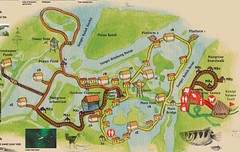The low tide of the day was at 0545 and the high tide at 1310; this meant that the tide would be coming in some time around 1100 and we have to check the place out before then.
Visitor Centre Mangrove Boardwalk out to the mudflats
Firstly, we took the route from MB1 out to the mangrove forests and trekked (or rather, scrunched) out following the stream to check out the large burrows in a couple of sites. Before venturing out to the mudflats, we saw relatively large burrows and were concluded to the the "schlosseri country" which is the land of the giant mudskippers (Periophthalmus schlosseri).
Next, we travelled outwards to the coastline and saw no mudskippers but horseshoe crabs making trails on the mud. We then trekked back inland towards Buloh East and spotted the slender mudskipper (Periophthalmus gracilis) which was so small and unnoticeable except when it was moving.
When we finally reached the artificially enlarged canal separating SBWR from Kranji Nature Trail (KNT), we finally found more burrows that have mudskippers with eyes like a scope of a submarine scanning the surroundings (for food/predators?). It was a good site for monitoring activities of the mudskippers with regards to behavioural or territorial displays via binoculars or a video camera. The side of the KNT was more inconspicuous to prevent affecting natural display from the mudskippers. That is one potential site, checked.
The Mangrove Arboretum
Next, we quickly went to the boardwalk at the Mangrove Arboretum at a time which was really close to the time that is coming in. Here we spotted numerous giant mudskippers and the yellow-spotted mudskipper (Periophthalmus walailakae), which was not easily distinguished from the other unless with the help of a pair of binoculars.
The giant mudskipper has green spots on the face and body but a distinct (sometimes not so obvious) black lateral stripe across its body. It is considerably larger than the other mudskippers and more easily spotted.
The yellow-spotted mudskipper has irregular whitish spots on the body and generally smaller than the giant mudskippers.
The blue-spotted mudskipper (Boleophthalmus boddarti) may be confused with the giant mudskipper with a lateral black line, but on closer look is actually due to seven diagonal bars that starts from the dorsal part of the body fading towards the ventral part. It is also smaller in size and may be seen "wading" on the surface of the mud, propelling itself by the lower portion of its body, swinging its head from left to right. This is a feeding behaviour as it feeds on the algae or small invertebrates found on the mud.
A quick note was that the bigger mudskippers will emerge from the burrows and the visible ones "scramble" towards the shore when the tide comes in. There is a continual climb for higher ground as the water rises. There is also displays of territorial disputes as mudskippers gape at one another, or chase the rest off fallen branches they are already on.
Another great site for observation.

Map of SBWR in SBWR Brochure.
Questions:
1. Where are the mudskippers during the low tide? Are they in the burrows or out in the sea foraging?
2. As the tide comes in, many giant mudskippers are spotted leaving their burrows for higher ground. Do they return to their burrows? If so, how do they recognize their own?
3. Why do they "retreat" to higher grounds?
4. Are the trails of the different mudskippers distinguishable from one another?
5. Can the mudskippers co-exist with others or is a site monospecific?
6. Where are the smaller mudskippers when the tide comes in? (They were not so visible in retreating to land.)
No comments:
Post a Comment